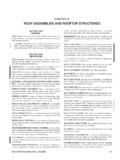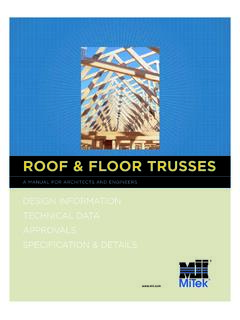Transcription of Electric Service Standards 11 -27 18 - Florida Power & Light
1 Electric Service Standards DATE 11-27-18 PREPARED BY SUBJECT V. REQUIREMENTS FOR TRANSFORMERS SITUATED ON CUSTOMER PROPERTY SECTION: PAGE Delivery Assurance Design Support V: 1 of 6 2018, Florida Power & Light Company Page 1 of 6 V. REQUIREMENTS FOR TRANSFORMERS SITUATED ON CUSTOMER PROPERTY A. Padmounted Transformer Requirements Complete requirements are contained in FPL specifications given to Customers for individual projects. Typical pad mounted transformer requirements include, but are not limited to the following: The Customer Will: - provide a transformer pad location per FPL specifications. Transformers should be installed at least 15 feet from doors and windows. If this is unachievable, the absolute minimum distance is 5 feet. Transformer installations between 5 and 15 feet must be approved by FPL Design and Standards ; - pour and cure the concrete pad according to FPL specifications, or install the FPL supplied pre-cast pad, for transformers sized 750 KVA and larger; - bring the Service entrance conductors out to the transformer, installed in accordance with National Electrical Code requirements, leaving adequate cable, as determined by FPL, for FPL to make connections in the transformer, the number of cables limited as shown below: Transformer KVA Secondary Voltage Max.
2 Number of Conductors Max. Conductor Size Max. Number of Conduits & Sizes 25 100 (Low Style) 120/240V 8 sets 4/0 8 2 Max 50 167 (High Style) 120/240V 8 sets 500 KCMIL 8 2 Max 6 Max 4 4 Max 150 500 120/208V 277/480/V 8 sets 750 KCMIL 8 4 Max 750 277/480V 8 sets 750 KCMIL 8 5 Max 750 120/208 V 12 sets* 750 KCMIL 12 5 Max 1000 277/480V 12 sets* 750 KCMIL 12 5 Max 1000 120/208V 12 sets* 750 KCMIL 12 5 Max 1500 - 2000 277/480V 12 sets* 600 750 KCMIL 12 5 Max 1500 - 2000 277/480V 14 sets* 500 KCMIL or less 14 5 Max 2500 277/480V 12 sets* 600 750 KCMIL 12 5 Max 2500 277/480V 16 sets* 500 KCMIL or less 16 5 Max *An FPL provided secondary connection cabinet is recommended for new installations with more than 6 sets of 750 KCMIL CU or more than 12 sets of a smaller size conductor. - maintain access to FPL to padmounted equipment located on the Customer's property (eight feet of clearance from the door side and three feet of clearance from other sides from items Electric Service Standards DATE 08-15-18 PREPARED BY SUBJECT V.)
3 REQUIREMENTS FOR TRANSFORMERS SITUATED ON CUSTOMER PROPERTY SECTION: PAGE Delivery Assurance Design Support V: 2 of 6 2018, Florida Power & Light Company Page 2 of 6 such as fences, shrubs and other obstructions are to be maintained by the Customer, as shown in Fig. V-1. FPL will help plan the Customer's installations of fences, shrubs, etc. near FPL facilities such that they will not obstruct access or cause damage to FPL's facilities. Where adequate access to FPL facilities is maintained, faster Service restoration is made possible in the event of a Power interruption.); - provide suitable barriers, if specified by FPL, to protect the padmounted transformer and associated metering equipment from vehicular traffic; - provide FPL with a suitable easement for the pad and distribution cables, including the right to install additional cables to serve other Customers, as required; - clear trench route, have to grade, as specified in section ; - conform to the requirements of the National Electrical Code and applicable local codes (approval from the local inspecting authority shall be provided to FPL before FPL will connect Service ).
4 FPL Will: - provide transformer specifications to the Customer; - determine if a secondary connection cabinet will be required; - provide and install the transformer, the concrete pad (if applicable), and the primary cable and conduit. If only one, single-meter Customer is served (greater than 600 amps), and no future additional meters will be connected, current transformers may be placed in padmounted transformer before the Customer's Service is tapped to its secondary. This would avoid the need for a current transformer cabinet. However, the meter socket and connecting conduit shall still be installed by the Customer. The meter socket will not be mounted on the padmounted transformer. The location of the meter socket will be specified by FPL. Electric Service Standards DATE 11-27-18 PREPARED BY SUBJECT V. REQUIREMENTS FOR TRANSFORMERS SITUATED ON CUSTOMER PROPERTY SECTION: PAGE Delivery Assurance Design Support V: 3 of 6 2018, Florida Power & Light Company Page 3 of 6 Fixed Barrier Removable Barrier FRONT F R O N T F R O N T All Front Barriers Removable Concrete Pad Concrete Pad Concrete Pad All Rear Barriers Fixed Parking Area or Paving Parking Area or Paving Parking Area or Paving Install additional barriers as required Transformer or Switch Transformer or Switch Transformer or Switch FIGURE V-1 Protective Barrier and Planting Clearances for Padmounted Transformers and Switches Drill 1/2 thru hole for lifting 4 Std.
5 Pipe with threaded cap Paint pipe to match transformer 5 Std. pipe sleeve Slope concrete for water shed 2 -0 16 3 -3 1 -6 3 3 -6 Min. 10 Machine Bolt (3/4 x 8 ) Galvanized Well tamped earth Paint pipe to match transformer Slope concrete for water shed Well tamped earth 16 3 -6 Min. Fill 4 Std. pipe with concrete, leave crown on concrete 12 2 -0 REMOVABLE BARRIER FIXED BARRIER Concrete Pad See Notes 1 & 2 See Notes 1 & 2 See Notes 1 & 2 3 Min 8 Min Opening for hot stick operation FRONT FPL Pad Mounted Equipment PLANTING CLEARANCES Note 1: Padmounted Transformers and pad may be located minimum 3 on both sides and back side only. An 8 minimum is required on the front side for access and hot stick operation. Note 2: Padmounted Switches and Cap Banks require 8 feet of clearance on all sides. 3 -0 Max. 9 Min. Bush Fence Wall Hedge Electric Service Standards DATE 08-15-18 PREPARED BY SUBJECT V.
6 REQUIREMENTS FOR TRANSFORMERS SITUATED ON CUSTOMER PROPERTY SECTION: PAGE Delivery Assurance Design Support V: 4 of 6 2018, Florida Power & Light Company Page 4 of 6 B. Vault Requirements Complete requirements are contained in FPL specifications given to Customers for individual projects. Typical vault requirements include, but are not limited to the following: The Customer will: Provide construct and maintain the transformer vault in accordance with applicable codes and FPL specifications, which specify, but are not limited to: - necessary layout information for such vaults, including the size, location and number of conduits to be stubbed out; - Customer to stub out ducts as specified beyond the building foundation, as shown on specifications vault drawing (fiber, plastic, or transite ducts shall be enclosed in concrete. Ells shall have a minimum radius of 36 inches); - in grade level vaults, Customer will provide 1-1/4 inch plastic conduit sleeves at specified locations through the concrete floor for FPL's ground rods; - provisions for adequate vault ventilation, as shown (ventilating fans, if needed, will be installed by FPL); - doors shall open outward, and shall have a hasp for padlocking or mortised openings for FPL provided Customer installed cylinder dead lock set.
7 Locks and latches shall be so arranged that the door may be readily and quickly opened from the inside. Doors opening into the building shall be tight fitting and of a type approved for a class A situation (see NFPA No. 80, latest edition). Customer is responsible for maintenance of walls, roof , doors and windows; - FPL provided, Customer installed pulling eyes opposite each duct entrance. Pulling eyes shall be tied into building steel and capable of withstanding 10,000 pounds tension in direc-tion shown in specifications; - floors of vault to have adequate structural strength to support the vault equipment; - drainage facilities provided and installed as required by applicable codes for "Transformer Vaults" (door sill of height as specified, minimum of four inches); - means of direct access to vault from outside for personnel and equipment, through doors opening outward (if this cannot be done, special arrangements shall be agreed on for moving personnel and equipment into and out of the vault.)
8 These arrangements shall be included in an addendum to the standard specifications); - if metering current transformers are located in the vault, Customer shall provide a continuous 1-1/2 inch metallic (threaded bushing on ends) or schedule 80 PVC conduit (without condulets) from the meter socket or cabinet to the inside of the vault wall (no metering equipment except instrument transformers are to be in the vault. Maximum distance of metering devices from conduit termination in vault to be ten feet, or FPL approved distance) with a maximum of 2 90 degree bends; - special restrictions (no pipes for sanitary plumbing, water or gas supply or for any other purpose foreign to the vault installation shall pass through the transformer vault; no toilets or wash basins shall be installed in the vault; any conduit or piping required in connection with sump pumps or other necessary equipment shall be insulated electrically from the exterior of the vault; vaults shall not be used for storage, nor for any other purpose than to contain and Electric Service Standards DATE 11-27-18 PREPARED BY SUBJECT V.
9 REQUIREMENTS FOR TRANSFORMERS SITUATED ON CUSTOMER PROPERTY SECTION: PAGE Delivery Assurance Design Support V: 5 of 6 2018, Florida Power & Light Company Page 5 of 6 protect the transformers and necessary equipment); (Note: Customer should submit the vault specifications to the appropriate authorities for their information at time of submitting construction plans for approval.) - provide and install his Service entrance and bring his secondary Service conductors into the transformer vault through designated areas only, leaving sufficient cable length in the vault for FPL to connect to its facilities. He will install meter protective equipment, in accordance with vault specifications; - grant to FPL an easement for the FPL conduit and cables within the Customer's property. FPL Will: - provide vault specifications to the Customer; - where accessible to employment of rapid and customary methods of construction, provide and install conduit from the conduit stubs at the transformer to its facilities; - provide, install, and connect the primary cable to the transformer vault; - provide and install the necessary transformer(s) and switching equipment; - perform all work inside the transformer vault associated with rendering Electric Service (with the exception of pulling customer cables); - maintain all of its facilities from its pole or manhole to where the Customer's secondary Service conductors are connected to FPL s facilities; - keep the vault locked (FPL will give the Customer escorted access to the vault, when necessary, upon request).
10 - reserve the right to install the necessary cables, conduit, and other facilities that may be required for supplying Service to other Customers from the vault; - allow only the supply transformers and associated FPL equipment in the vault (No meters or Customer secondary fuses, switches, communications or other Customer equipment are to be installed therein. Secondary devices and meters, however, are to be installed as near the transformer vault as practicable, but not in it). Electric Service Standards DATE 08-15-18 PREPARED BY SUBJECT V. REQUIREMENTS FOR TRANSFORMERS SITUATED ON CUSTOMER PROPERTY SECTION: PAGE Delivery Assurance Design Support V: 6 of 6 2018, Florida Power & Light Company Page 6 of 6 C. "Stacked Vault" Requirements Complete requirements are contained in FPL specifications given to Customers for individual projects. Typical stacked vault requirements include, but are not limited to the following: The Customer will: - provide, construct and maintain the vaults in accordance with FPL's specifications, the National Electrical Code and any local building code; - provide ducts enclosed in at least two inches of concrete, for FPL's primary cables; - provide soundproofing necessary to contain the noise from transformers, each having a noise level of 45 Decibels.


